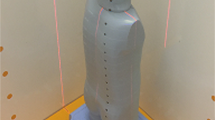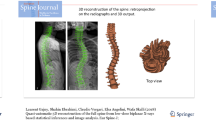Abstract
Introduction
As the analysis of scoliosis requires global and local three-dimensional (3D) examinations of the spine in standing position, stereoradiography appears as one of the most adequate 3D imaging tools for its diagnosis. However, the definition level of the 3D stereoradiographic model may still be too low for local analysis.
Objectives
(1) To increase the geometric definition of the 3D stereoradiographic reconstruction to obtain morpho-realistic models, and (2) to validate the accuracy of this technique using radiographs providing by a low-dose digital X-ray device.
Method
Detailed generic objects for each vertebral level (approximately 2,000 points) were obtained using average models (approximately 200 points), from an existing data base of direct measurements in association with CT scan 3D model (2,000 points). Validation of these models was performed by comparing detailed stereoradiographic reconstructions of 36 dry human vertebrae belonging to each spinal level with the corresponding CT-scan reconstructions.
Results
Comparison protocol between the detailed stereoradiographic reconstructions and the CT-scan reconstructions indicated mean (RMS) reconstruction errors of 0.7 mm (0.9), 0.9 mm (1.2) and 0.9 mm (1.2) for lower cervical, thoracic and lumbar levels respectively. Results showed 3D personalised models of 2,000 points without any loss of accuracy in comparison to previous studies.
Conclusion
This study yields morpho-realistic, personalised 3D geometric models (accuracy close to CT-scan reconstruction) with a low irradiation dose.
Résumé
Introduction
La scoliose nécessitant un examen 3D du sujet en position debout, tant au niveau global qu'au niveau local, la stéréoradiographie apparaît comme un des outils d'imagerie 3D le mieux adapté pour son analyse. Cependant, le niveau de définition des modèles 3D utilisés dans cette technique reste encore trop faible pour une analyse locale réellement performante.
Objectifs
(1) augmenter la définition des modèles 3D reconstruits par stéréoradiographie de façon à obtenir des modèles morpho-réalistes, et 2) valider la précision de cette technique en utilisant des radiographies provenant d'un système numérique à basse dose d'irradiation.
Méthode
Pour chaque niveau vertébral, des modèles génériques détaillés ont été obtenus en associant des modèles moyens (200 points), fournis par une base de donnée de mesures directes, avec des modèles 3D CT-scan (2.000 points). Pour 36 vertèbres sèches, la comparaison des reconstructions stéréoradiographiques obtenues à partir de ces modèles détaillés avec les reconstructions CT-scan correspondantes a été réalisée, permettait ainsi une validation des modèles.
Résultats
Les résultats du protocole de comparaison indiquent des erreurs moyennes de reconstruction de 0.7 mm (0.9 RMS), 0.9 mm (1.2 RMS) et 0.9 mm (1.2 RMS) pour les niveaux cervicaux, thoraciques et lombaires, respectivement.
Conclusion
Cette étude propose donc une méthode stéréoradiographique permettant de reconstruire des modèles de vertèbres 3D morpho-réalistes et personnalisés (précision proche des reconstructions CT-scan) avec une faible dose d'irradiation.




Similar content being viewed by others
References
André B, Dansereau J, and Labelle H (1994) Optimized vertical stereo base stereoradiographic setup for the clinical three-dimensional reconstruction of the human spine. J Biomech 27:1023–1035
Aubin CE, Dansereau J, Parent F, Labelle H, De Guise JA (1997) Morphometric validation of personalized 3D reconstruction and geometric models of the human spine. Med Biol Eng Comp 6:611–618
Brown RH, Burstein AH, Nash CL, Schock CC (1976) Spinal analysis using a three-dimensional radiographic technique. J Biomech 9:355–365
De Guise JA, Martel Y (1988) 3D biomedical modelling: merging image processing and computer aided design. IEEE EMBS 10th International Conference, New Orleans: 426–427
Delorme S (1996) Application du krigeage pour l'habillage et la personnalisation de modèle géométrique de la scoliose. Mémoire de Maîtrise, Ecole Polytechnique de Montréal
Dubousset J (1992) Importance of three-dimensional concept in the treatment of non scoliotic deformities. Proc Int Symp 3D Scoliotic Deformities, Montréal 302–311
Dansereau J and Stokes IAF (1988) Measurements of three-dimensional shape of the rib cage. J Biomech 21:893–901
EVAL (1996) Evaluation clinique d'un appareil de radiologie numérique développé à Novosibirsk à partir des détecteurs de particules du Pr. Georges Charpak; Synthèse
Ismael B (1995) Etude morphométrique des vertèbres thoraciques. Mémoire de DEA, LBM ENSAM, Paris
Kalifa G, Boussard JM (1996) L'appareillage de radiologie numérique dit Charpak. J Radiol 77–85
Landry C, De Guise JA, Dansereau J, Labelle H, Skalli W, Zeller R and Lavaste F (1997) Analyse infographique des déformations tridimensionnelles des vertèbres scoliotiques. Ann Chir 51:868–874
Labelle H, Dansereau J, Bellefleur C, Jequier JC (1995) Variability of geometric measurements from three dimensional reconstructions of scoliotic spines and rib cages. Eur Spine J 20(23):2487–2496
Maurel N (1993) Modélisation géométrique et mécanique tridimensionnelle par éléments finis du rachis cervical inférieur. Thèse de doctorat en mécanique, LBM-ENSAM, Paris
Mitton D, Landry C, Véron S, Skalli W, Lavaste F, and De Guise JA (2000) 3D reconstruction method from biplanar radiography using non-stereo-corresponding points and elastic deformable meshes. Med Biol Eng Comput 38:133–139
Mitulescu A, Semaan I, De Guise JA, Leborgne P, Adamsbaum G, and Skalli W (2001) Validation of the non-stereo-corresponding points stereoradiographic 3D reconstruction technique. Med Biol Eng Comput 39:152–158
Mitulescu A (2001) Contribution à la reconstruction tridimensionnelle du rachis et du bassin à partir de la stéréoradiographie conventionnelle et basse dose (Charpak). Thèse de doctorat en mécanique, LBM-ENSAM, Paris
Parent S, Mitulescu A, Semaan I, Skalli W, Lavaste F, de Guise JA, and Labelle H (2000) Morphometric analysis of normal thoracic vertebrae, The Canadian Orthopaedic Research Society 34th annual meeting, Edmonton, Alberta, 3–6 Juin
Pearcy MJ, Whittle MW (1982) Movements of the lumbar spine measured by three-dimensional X-ray analysis. J Biomed Eng 4:107–112
Perdriolle R (1979) La scoliose: son aspect tridimensionnel. In: Maloine (ed.), Paris
Perdriolle R, Vidal J (1987) Morphology of scoliosis: Three-dimensional evolution. Orthopaedics 10(6):909–915, 785–791
Rainaut JJ (1994): Les scolioses. Ellipse (ed), Paris
Selvik G, Olsson TH, and Willner S (1976) High accuracy analysis of movement of the spine with the aid of a roentgen stereophotogrammetry method. In: Komi, PV (ed) Biomechanics V-B, University Park Press, Baltimore, pp 502–507
Semaan I, Skalli W, Veron S, Templier A, Lavaste F (2001) Anatomie quantitative tridimensionelle du rachis lombaire. Revue de Chirurgie Orthopédique et Réparatrice de l'Appareil Locomoteur 87:983–992
Stokes IAF, Wilder DG, Frymoyer JW, Pope MH (1981) Assessment of patient with low back pain by biplanar radiographic measurement of intervertebral motion. Spine 6:233–240
Trochu F (1993) A contouring program based on dual kriging interpolation. Eng Comput 9:160–177
Veron S (1997) Modélisation géométrique et mécanique tridimensionnelle par éléments finis du rachis cervical supérieur. Thèse de doctorat en mécanique, LBM-ENSAM, Paris
Acknowledgement
The authors thank A. Mitulescu for her technical advice, as well as Biospace Instruments for financial support.
Author information
Authors and Affiliations
Corresponding author
Rights and permissions
About this article
Cite this article
Le Bras, A., Laporte, S., Mitton, D. et al. Three-dimensional (3D) detailed reconstruction of human vertebrae from low-dose digital stereoradiography. Eur J Orthop Surg Traumatol 13, 57–62 (2003). https://doi.org/10.1007/s00590-003-0074-5
Received:
Accepted:
Published:
Issue Date:
DOI: https://doi.org/10.1007/s00590-003-0074-5




